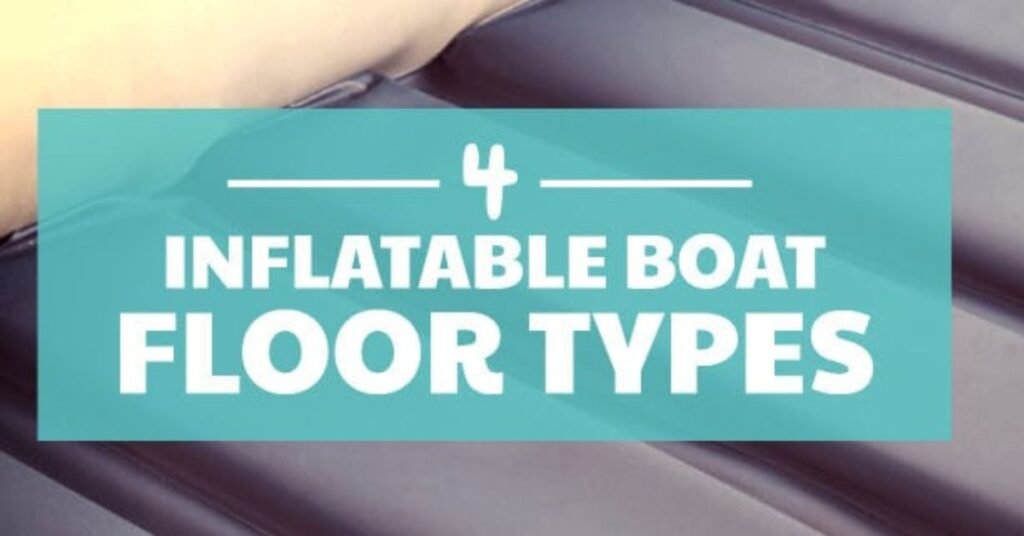The flooring of an inflatable boat is an important factor to consider, since each floor type has it’s uses, pros and cons. The 4 types of flooring you’ll encounter in inflatable boats are:
- roll up floors
- hard floors
- air floors
- rigid floors in RIBs
Roll-up slat floor
The most basic inflatable boat floor type is the roll-up floor, also known as slat floor.
As you can see on the image above, the roll-up floor is made up of lateral slats with gaps in between each slat. The slats are made of various materials such as aluminium or wood.
The slat floor is easy to assemble, roll up and store, however, they are not that rigid, making them somewhat hard to stand on.
Inflatable boats that use slat flooring are designed with simplicity in mind. They are great for short trips, but lack performance in choppy waters and while turning.
The size of inflatable boats that use roll-up floors varies from about 5 feet (carries 1 person) to 9 feet (carries 4 people).
- easy to roll up and carry
- storage in relatively small spaces
- less expensive than hard floor
- lack of rigidity
- hard to stand on
- broken slats can damage fabric thus prone to tears
- usually no keel
Hard floor
Inflatable boats with a hard floor offer higher durability and increased performance over slat floored boats. This type of floor is also made of aluminium or wood.
The hard floor makes the craft rigid and more durable than roll-up floors. You can think of hard floors as the backbone of the boat, providing more rigidity and stability.
The added rigidity allows the use of inflatable V-shaped keels, which run along the bottom of the boat. The combination of the hard floor and keel makes maneuvering and turning easy (even in choppy waters) and allows the boat to get on plane.
The added versatility of hard floor inflatable crafts give them the ability to be used for many things, including fishing boats, yacht tenders, dive boats, and more.
The size of hard floor inflatable boats can vary from 7 feet to 23 feet.
- durable
- stable
- versatile
- more expensive
- longer time to assemble
- harder to carry and store
Air floor (air deck)
A modern air floor is a separate flat tube, which inflates just like the larger side tubes.
Air floors allow for high pressure inflation (often inflated to 8-12 psi), making them rigid enough to stand and even jump on, yet weigh considerably less than a hard floor boat.
Of course, they will not be as stiff as hard floors, and will allow for some flex.
Air floors are made of very tough material, which makes them more expensive than hard floors. They are constructed from specially designed drop-stitched PVC, often called Double Wall Fabric. The 2 sides of the air floor are held together by thousands of interwoven stitches.
They are easy to store, since they can simply be deflated and wrapped up with the boat itself. This is an important consideration for a lot of people who choose an inflatable boat.
Like hard floors, inflatable keels are used in conjunction with air floors, giving these boats better maneuverability. However, their reduced weight and higher center of gravity will make them less stable at higher speeds.
Another advantage air floors have over hard floors is that they are soft. Sitting or kneeling on air floors is much more comfortable, especially for kids in the boat.
If you buy an inflatable boat with an air floor, keep in mind that water temperature has an effect on the air pressure in the floor. If the water is cool, the air will condense, so you may need to inflate more air into it.
TIP: If you plan on using your boat for fishing or carrying things around, you can avoid puncturing the air floor by laying a cut-to-shape vinyl piece or carpet onto the floor.
- additional buoyancy
- stable
- saves weight and storage space
- portable
- easier and faster to assemble than hard floor
- comfortable for sitting/kneeling
- reduced weight means less stability
- more expensive
- can’t mount anything onto it, like you could on aluminum or wooden panels (think fish finder, real seat, etc.)
Cheaper inflatable rafts that are used as toys also have an air floor, but they are simple ribbed inflatable tubes mostly suitable for playing on the water.
RIBs
RIB is an abbreviation for rigid hulled inflatable boat. This means that the hull (bottom) of the inflatable boat is constructed like a traditional boat.
With this come advantages and trade-offs, which you can read about extensively in this article.
Self-bailing floor
Self-bailing floors are also a feature you might want to consider.
Non-bailing standard floors have the flooring sealed to the tubes, which means that water splashed into the boat stays there until scooped out.
Self-bailing floors, on the other hand, have holes located on the sides of the floor. The water that gets splashed into the cockpit exits through these wholes.
This is especially useful in situations where you would expect a lot of water to enter the cockpit, like white-water rafting.
Which floor type is best?
Now you know the specifics of all 4 floor types an inflatable boat may come with, you probably have an idea of which one you would prefer.
Each type has it’s advantages and disadvantages, so choosing may not be easy.
Here are a few things you should consider:
- What you will be using your boat for? Going fast requires a boat with a keel. Whitewater rafting requires a based self-bailing floor that is not rigid. Taking the kids around the lake is best with a comfortable air floor. Fly fishing from an inflatable raft is best with a hard floor where the angler can easily stand and balance.
- Where you will use the boat? Flat water? Running river? Choppy sea?
I have owned inflatable boats with all kinds of floors. In general, I’ve found that:
- Drop stitched air floors are the most comfortable for riding in and in terms of storage, but also the most expensive.
- Hard floors are best for going fast with an outboard motor. They don’t flex and are stable. They do require an extra few minutes to set up, but once you get into it, it’s not that bad. Just make sure your trunk is big enough to put them in when disassembled, if you plan on moving it around of course.
- Slated roll up floors are the least expensive choice. They don’t require much care, but of course, there is a trade off. They are the least stable on the water. Some roll up floors where the slates are very close together are OK, but the ones that are further apart are pretty unstable.
The floor type available to you also depends on the type of inflatable boat you get. All of the above floorings are available for inflatable dinghies and sports boats. Inflatable pontoon boats don’t have any of the above floor types, you would stand on their metal frame. Inflatable kayaks have air floors only.
I hope this helps, please let me know if you have any questions or comments in the comment section below.
CLICK HERE FOR MORE BLOG POSTS







